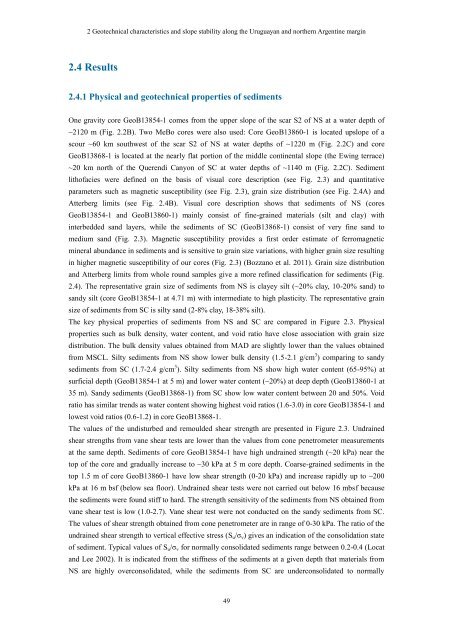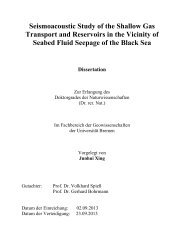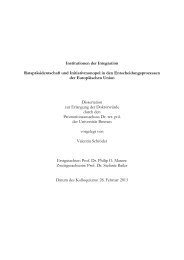Slope stability along active and passive continental margins ... - E-LIB
Slope stability along active and passive continental margins ... - E-LIB
Slope stability along active and passive continental margins ... - E-LIB
You also want an ePaper? Increase the reach of your titles
YUMPU automatically turns print PDFs into web optimized ePapers that Google loves.
2 Geotechnical characteristics <strong>and</strong> slope <strong>stability</strong> <strong>along</strong> the Uruguayan <strong>and</strong> northern Argentine margin<br />
2.4 Results<br />
2.4.1 Physical <strong>and</strong> geotechnical properties of sediments<br />
One gravity core GeoB13854-1 comes from the upper slope of the scar S2 of NS at a water depth of<br />
~2120 m (Fig. 2.2B). Two MeBo cores were also used: Core GeoB13860-1 is located upslope of a<br />
scour ~60 km southwest of the scar S2 of NS at water depths of ~1220 m (Fig. 2.2C) <strong>and</strong> core<br />
GeoB13868-1 is located at the nearly flat portion of the middle <strong>continental</strong> slope (the Ewing terrace)<br />
~20 km north of the Querendi Canyon of SC at water depths of ~1140 m (Fig. 2.2C). Sediment<br />
lithofacies were defined on the basis of visual core description (see Fig. 2.3) <strong>and</strong> quantitative<br />
parameters such as magnetic susceptibility (see Fig. 2.3), grain size distribution (see Fig. 2.4A) <strong>and</strong><br />
Atterberg limits (see Fig. 2.4B). Visual core description shows that sediments of NS (cores<br />
GeoB13854-1 <strong>and</strong> GeoB13860-1) mainly consist of fine-grained materials (silt <strong>and</strong> clay) with<br />
interbedded s<strong>and</strong> layers, while the sediments of SC (GeoB13868-1) consist of very fine s<strong>and</strong> to<br />
medium s<strong>and</strong> (Fig. 2.3). Magnetic susceptibility provides a first order estimate of ferromagnetic<br />
mineral abundance in sediments <strong>and</strong> is sensitive to grain size variations, with higher grain size resulting<br />
in higher magnetic susceptibility of our cores (Fig. 2.3) (Bozzano et al. 2011). Grain size distribution<br />
<strong>and</strong> Atterberg limits from whole round samples give a more refined classification for sediments (Fig.<br />
2.4). The representative grain size of sediments from NS is clayey silt (~20% clay, 10-20% s<strong>and</strong>) to<br />
s<strong>and</strong>y silt (core GeoB13854-1 at 4.71 m) with intermediate to high plasticity. The representative grain<br />
size of sediments from SC is silty s<strong>and</strong> (2-8% clay, 18-38% silt).<br />
The key physical properties of sediments from NS <strong>and</strong> SC are compared in Figure 2.3. Physical<br />
properties such as bulk density, water content, <strong>and</strong> void ratio have close association with grain size<br />
distribution. The bulk density values obtained from MAD are slightly lower than the values obtained<br />
from MSCL. Silty sediments from NS show lower bulk density (1.5-2.1 g/cm 3 ) comparing to s<strong>and</strong>y<br />
sediments from SC (1.7-2.4 g/cm 3 ). Silty sediments from NS show high water content (65-95%) at<br />
surficial depth (GeoB13854-1 at 5 m) <strong>and</strong> lower water content (~20%) at deep depth (GeoB13860-1 at<br />
35 m). S<strong>and</strong>y sediments (GeoB13868-1) from SC show low water content between 20 <strong>and</strong> 50%. Void<br />
ratio has similar trends as water content showing highest void ratios (1.6-3.0) in core GeoB13854-1 <strong>and</strong><br />
lowest void ratios (0.6-1.2) in core GeoB13868-1.<br />
The values of the undisturbed <strong>and</strong> remoulded shear strength are presented in Figure 2.3. Undrained<br />
shear strengths from vane shear tests are lower than the values from cone penetrometer measurements<br />
at the same depth. Sediments of core GeoB13854-1 have high undrained strength (~20 kPa) near the<br />
top of the core <strong>and</strong> gradually increase to ~30 kPa at 5 m core depth. Coarse-grained sediments in the<br />
top 1.5 m of core GeoB13860-1 have low shear strength (0-20 kPa) <strong>and</strong> increase rapidly up to ~200<br />
kPa at 16 m bsf (below sea floor). Undrained shear tests were not carried out below 16 mbsf because<br />
the sediments were found stiff to hard. The strength sensitivity of the sediments from NS obtained from<br />
vane shear test is low (1.0-2.7). Vane shear test were not conducted on the s<strong>and</strong>y sediments from SC.<br />
The values of shear strength obtained from cone penetrometer are in range of 0-30 kPa. The ratio of the<br />
undrained shear strength to vertical effective stress (S u /σ v ) gives an indication of the consolidation state<br />
of sediment. Typical values of S u /σ v for normally consolidated sediments range between 0.2-0.4 (Locat<br />
<strong>and</strong> Lee 2002). It is indicated from the stiffness of the sediments at a given depth that materials from<br />
NS are highly overconsolidated, while the sediments from SC are underconsolidated to normally<br />
49
















